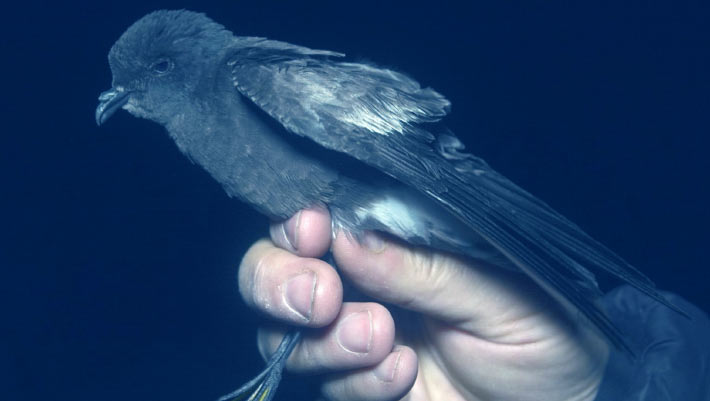An international team of ornithologists has described a cryptic new species of the bird genus Oceanites from Chile.
The Andean storm-petrel (Oceanites barrosi). Image credit: Norambuena et al., doi: 10.11646/zootaxa.5486.4.1.
Oceanites is a small genus of seabirds in the family Oceanitidae, which includes all the small storm petrels of the southern hemisphere.
“The family Oceanitidae is comprised of storm-petrels that have their phylogeographic origin in the southern hemisphere, including 10 species among the genera Oceanites, Garrodia, Pelagodroma, Fregetta, and Nesofregetta,” said Universidad Santo Tomás paleontologist Heraldo Norambuena and colleagues.
“The at-sea distribution of this family includes tropical, temperate, subantarctic, and Antarctic seas in the southern hemisphere, including temperate waters of the North Atlantic.”
“The family was formerly considered a subfamily within Hydrobatidae, even though scientists long ago had suggested, based on osteological and myological analyses, that the species within Oceanitidae do not group with other storm-petrels.”
“More recently, molecular phylogenetic studies confirmed that Oceanitidae is not a sister clade to Hydrobatidae. However, systematics within Oceanitidae remain unclear, especially within the genus Oceanites.”
“Currently, it is accepted that the genus Oceanites comprises three species: Oceanites oceanicus, Oceanites gracilis, and Oceanites pincoyae. But the taxonomic status of subspecies (and some species) continues to be controversial.”
In their new study, the researchers aimed to evaluate species limits in the Oceanites oceanicus complex under the hypothesis that this species complex corresponds to more than one species.
They analyzed new mitochondrial sequence data and morphological measurements of all species and subspecies in Oceanites, including the cryptic new species from the Chilean Andes.
“Considering that Oceanites are cryptically colored with conservative plumage variation, the best approach to understanding the distribution of each taxon will be the breeding distribution,” they said.
“The new species, Oceanites barrosi, in central Chile appears to breed in a region isolated from Oceanites gracilis to the north and Oceanites pincoyae to the south, all of which are far from the known breeding distribution of Oceanites chilensis.”
“Oceanites gracilis breeds largely in the Atacama Desert; while Oceanites barrosi clearly breeds in the Andes of central Chile based on multiple lines of evidence.”
The team’s analysis also suggests a colonization process of the ancestor of Oceanites from the Southern Ocean to the Southeast Pacific that generated Oceanites gracilis, Oceanites pincoyae, and Oceanites barrosi around 15-18 million years ago.
“The colonization of Antarctica occurred around 17 million years ago and promoted the occurrence of Oceanites exasperatus in that continent,” the authors said.
“Colonization of the Atlantic (Oceanites oceanicus) would have occurred from the Southeast Pacific 15 million years ago.”
“However, these patterns should be better understood with a genomic or multilocus approach allowing the divergence time between groups to be evaluated more precisely.”
The findings were published July 29, 2024 in the journal Zootaxa.
_____
Heraldo V. Norambuena et al. 2024. Resolving the conflictive phylogenetic relationships of Oceanites (Oceanitidae: Procellariiformes) with the description of a new species. Zootaxa 5486 (4): 451-475; doi: 10.11646/zootaxa.5486.4.1

